Perfect Picnics
It may officially be Autumn but the weather (mostly) is still good enough to get outdoors and have a picnic. This blog is as tightly packed as our picnic basket with loads of great stuff including reviews of some innovative picnic products and a cool game you can play for free at your perfect picnic…

Tilda & I LOVE a picnic
Children’s Wood
We headed off to the Children’s Wood (1) in Glasgow at the weekend to meet my BFF Euan for a picnic. If you haven’t already been there it is well worth a visit – it is a magical place, filled with trees, veg beds, mud kitchens, tree houses, swings and all sorts of fun, natural things to play with. The perfect spot for playing and picnics! Two of my favourite things.

We love exploring in the Children’s Wood
Woodland Trust
We were armed with the Woodland Trust’s “Tree Party” picnic pack which is filled with fun ideas for picnics. Our favourite part was doing the Scavenger hunt:

Scavenger hunts are sooooo much fun
It also inspired us to make our very own noughts & crosses game. We found the perfect tree stump as a board, some twigs to make the grid and different coloured stones to use as markers. It was great fun!
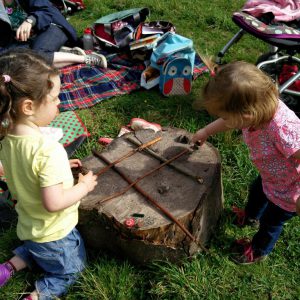
Tilda is pretty good at noughts & crosses!
Eco Snack Wrap
All this playing left us really hungry so it was time to raid the picnic and try out some new products which we had been sent. First were some wrappers from eco snack wrap. We had two sizes of sandwich wraps – a smaller size perfect for Tilda and me and a large one perfect for, yup you guessed it, Daddy! We also had a pouch which we popped some pancakes into. They are so much better than using sandwich bags or foil/cling film. Much better for the environment and they look so cute too. They come in a wide range of designs and prices start at £6.25. We definitely recommend them!
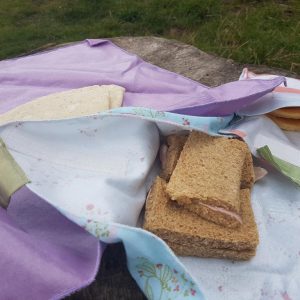
The eco wraps are a must-haves for picnics
Sistema Chill it to Go
Daddy also tried out the Sistema Chill it to Go container which is an innovative tub for taking salads on the go. Basically, your salad goes in the main section, there is a neat cool box which fits neatly on the top and has a little hole where a pot for your salad dressing fits perfectly. There is even cutlery hiding in the top! Daddy’s salad stayed perfectly chilled. No excuse for soggy, warm salads any more! The Sistema range is available in a wide range of supermarkets and shops from around £5.49.
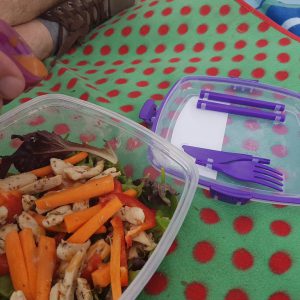
The Chill it to Go containers is perfect for salads on the go
So get out there and make the most of the late summer sunshine and have a perfect picnic.
Lulu xx
(1) Developers are wanting to build houses in this wonderful green space in Glasgow which would be a catastrophic loss to the many people of Glasgow who use the space (and visitors who come there to visit) and get to enjoy and learn about nature in its true setting. Please visit their website to learn more about this great cause and how you can help ensure it is there for future generations.
Prices correct at time of publishing.
The Foody: Time to Plant
Back in February, we introduced you to the Foody, a revolutionary new way to allow you to plant a wide range of fruit and veg in the tiniest of spaces. In February it was only warm enough to build it and get used to how it worked and make plans for what we would plant in it one sunny day. Well, that sunny day has finally arrived so here is how the Foody looks planted up and what we think of it so far…
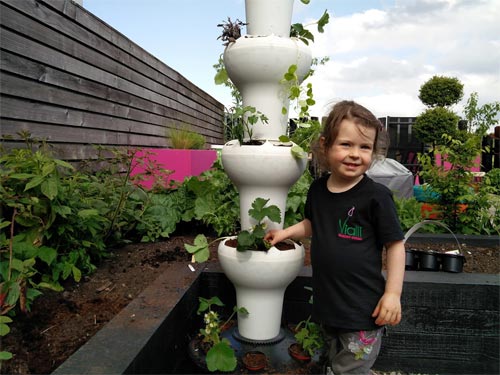
Our Foody, all planted up and looking great!
As we explained in our previous blog, the Foody is a vertical growing system which only needs a fraction of the water and space of traditional growing methods. You can choose different numbers of tiers depending on how tall you want to go. We are trialling the Foody 5, the daddy of the Foody world! So, what did we do?…
Well, we had already built the Foody when it arrived back in February so we were raring to go. We just needed to add our growing medium (compost, coir, whatever you prefer) and decide on what plants/seeds we were going to grow.
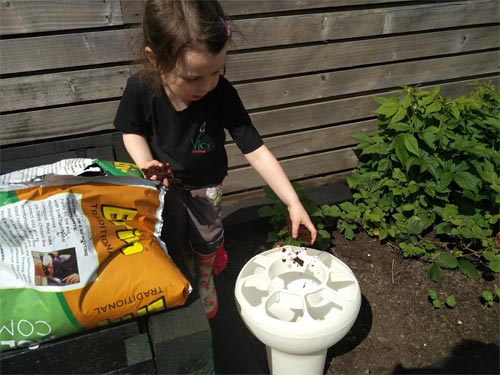
First you need to fill up your Foody with some compost
As we have the Foody 5, we had a whopping 39 spaces to fill! That’s a lot of different types of fruit and veg. We have gone for a yummy selection of things which we love to eat including:
- Bush tomatoes
- Courgettes
- Different types of salad leaves
- Spinach
- Rocket
- Radish
- Spring onions
- Strawberries
- Lots of different kinds of herbs.
We have all of these things growing in traditional methods around the garden too so we can compare how well the Foody works to them.
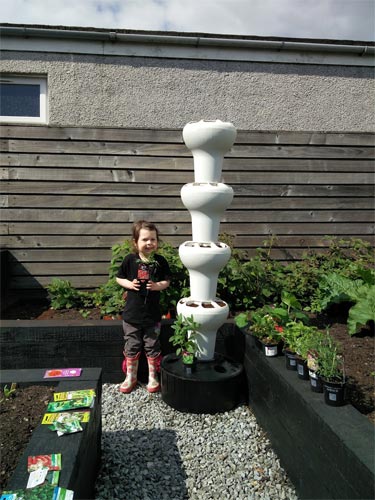
We needed lots of plants and seeds to fill our Foody!
The Foody looks really stylish and makes a real statement in the garden. It is also well made and looks like it will last well. It was great fun planting up the Foody as it’s such an unusual way to garden. To be able to fit all of this fruit and veg into such a tiny corner of our garden is amazing and we think it would be a wonderful solution for those with little space or who want to try “grow your own” without giving up too much garden space. The whole Foody spins easily so you can turn it around and make sure all areas get good sunlight as well as making it easy to water.

Gently plant your fruit and veg into the different pods (or
you could plant flowers to make an amazing floral sculpture!)
We are also very interested to see if it means our courgettes can escape being ravaged by slugs and snails or if they will make the journey up high! As our garden is a little windy and as we have the super-tall Foody 5, Daddy has had to build a collar for the Foody so that it doesn’t fall over in the wind. It would be good if the taller Foodies came with something to help stabilise them. Or if you live in a windy area then just choose one of the two shorter Foodies which will solve this issue.
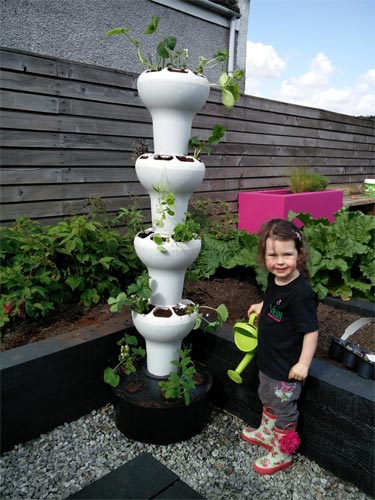
Once planted, water your Foody. The clever reservoir
in the bottom holds the water so you use much less water.
We will keep you posted as the season goes on but we are certainly loving our Foody adventure so far. For more information on the Foody visit LIFE.
Lulu x
Introducing the Foody…
We were sent a weird but wonderful new contraption through the post this weekend and I had lots of fun showing M&D how to build it (they needed an expert like me to keep them right). Read on to find out what it is and what we are going to be doing with it…
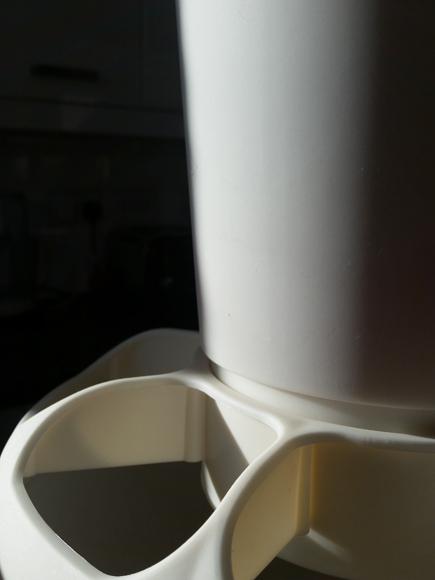
What in the world could this bed? A space ship?
A cup holder? Read on to find out more….
The Foody is a vertical growing system designed to provide the perfect environment to grow herbs, salads and flowers. It also only requires 10% of the water used in a traditional garden and can be used indoors or outdoors.
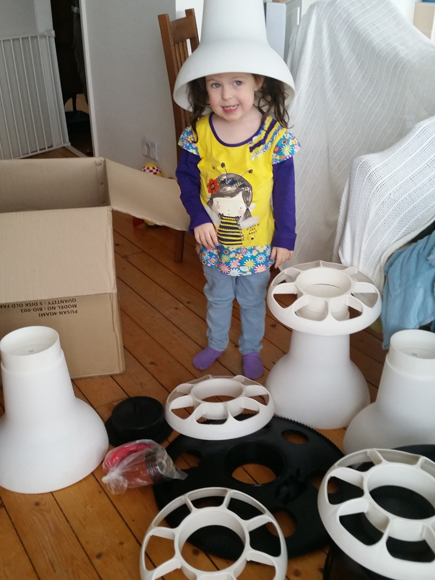
It’s a funky hat, that’s what it is!
But Lulu, how does it work I hear you ask? Well, when you water the top pod the water slowly drains down to the reservoir in the bottom. Cleverly, there are six extra pots down there with wicks which can use this water too.
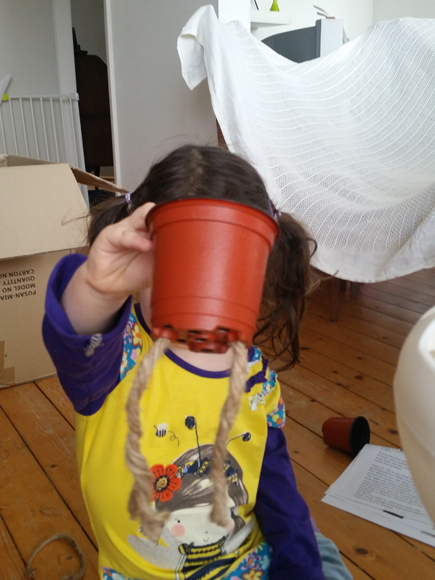
Lookee here, there are pots at the bottom and the
rope acts a wick to sook up all the water from below
As it can also be used indoors (and it looks pretty cool too) it means you can be growing salads and herbs all the year round, even up here in chilly Scotland!
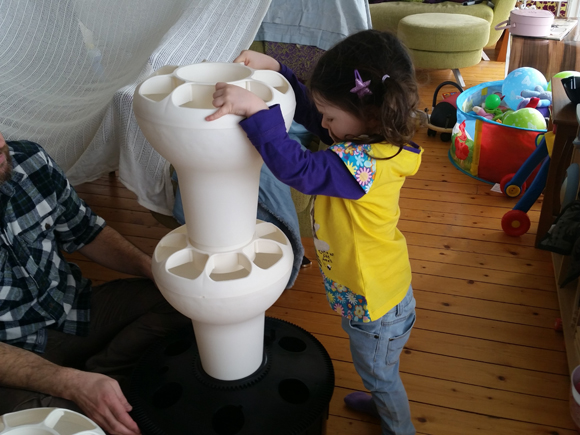
I start to add the towers on to our reservoir. You can choose a
Foody 3, 4 or 5 which have different levels to suit you
And if you really want to, you can even add a pump so that the watering is done automatically (watering is one of my favourite parts though as I get to splash in the water and look for fruit and veg at the same time!)
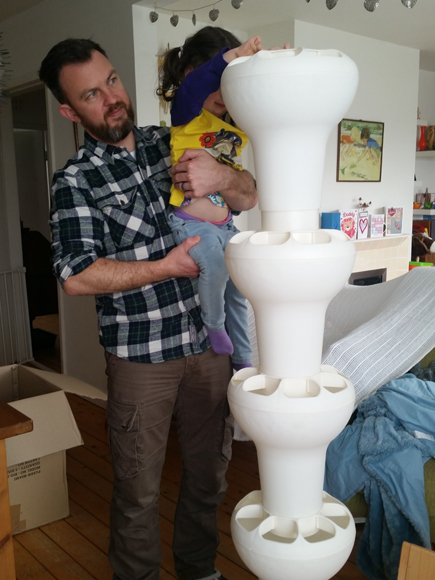
Wow, it’s getting tall now, I need a
little hand to reach up to add this pod!
The Foody is perfect when you have limited space and can be used in greenhouses, balconies, roof terraces, patios, you name it. And it cleverly rotates too so that you can make sure all sections get their share of the sun as required.
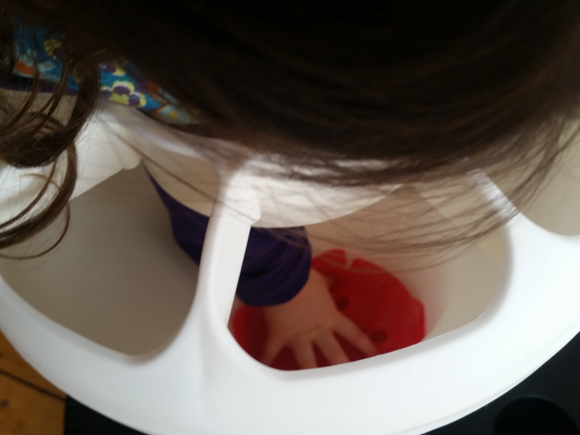
You get some material to add to the bottom of each pod to stop
any soil being washed down through the drainage holes
And as you can see from the pics it is super easy to put together. We’ll be trialing a selection of fruit and veg in our Foody 5 (you can grow all sorts in them and I will be growing strawberries, tomatoes, radish and tomatoes to name just a few) over the coming months and will keep you posted of our results.
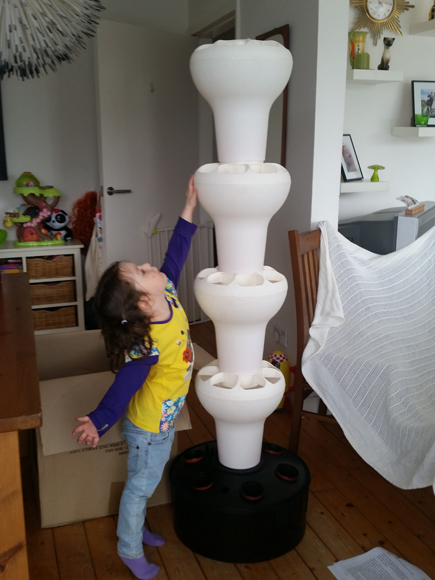
Wow, our Foody 5 is waaaaay tall!
For more information on the Foody go visit the lovely people over at LIFE.
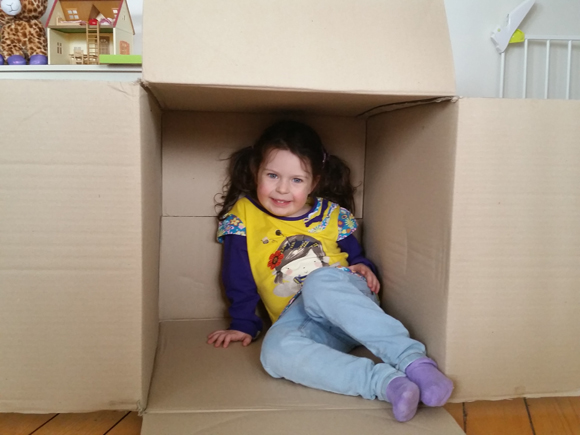
Plus you get a free box for hours of fun!
Lulu xx
Pallet Perfection
The landscaping side of our business gets a LOT of materials delivered on pallets. Lately we have been giving some thought to what we could use the leftover pallets for. Here are some of the items we have made from upcycled pallets so far:
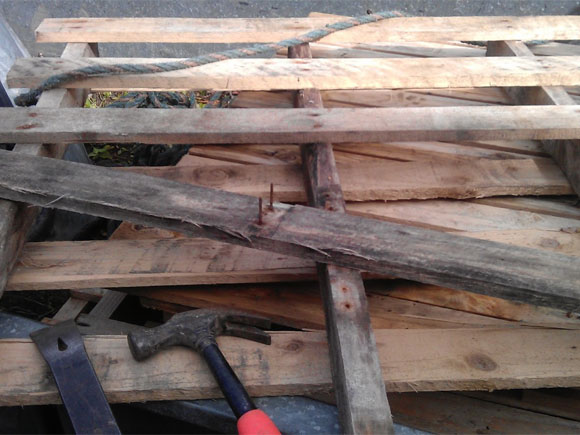
Some old pallets being stripped ready for a new life
Planters
These pretty planters can be made to whatever size or shape suits your garden. We have made a few herb planters so far but we have a tray of alpines waiting to be re-homed into a brand new pallet planter at our front door. These can easily be personalised by spraying whatever words you want onto the front. To read how to make your own pallet planter click here. Or contact us to order your own bespoke planter.
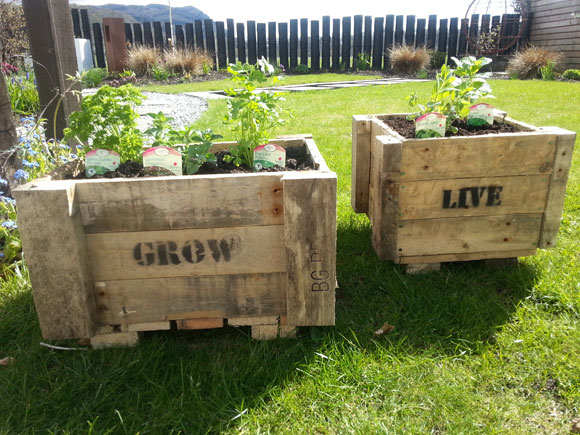
Pallet planters
Gate
We have been meaning to add a gate to our back garden for a while now, to help keep our little one from escaping. We decided to make a unique gate out of pallets and used a vintage garden tool as a handle. We will be adding some suitable wording to the horizontal slat soon.
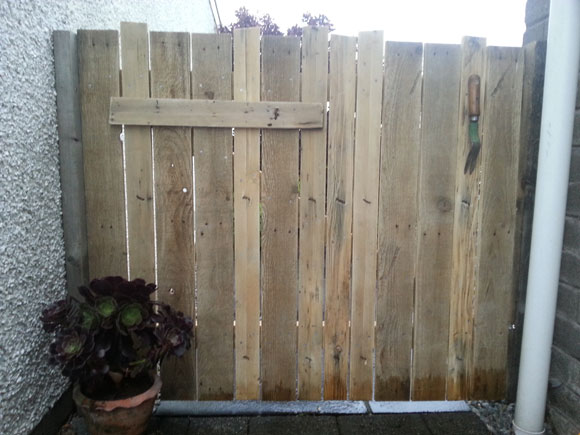
Pallet gate
Sand pit
Essentially, a large planter, the sand pit is proving to be a very popular addition to the range. Just make sure you sand down the pales well and you use a robust liner inside. Oh and add a lid so that local cats don’t use it as their very own outdoor litter tray! Again, this can be personalised and we have added a hole in one corner for a windmill 🙂
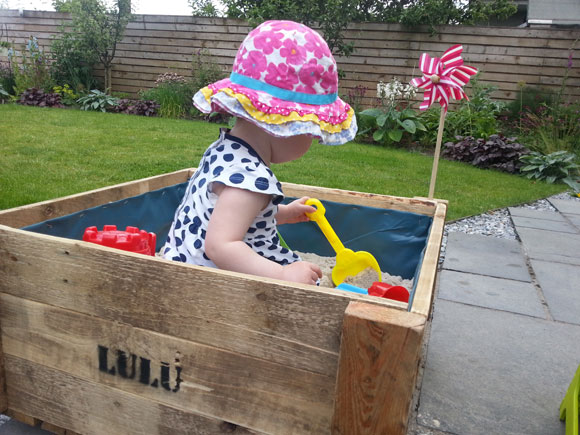
Pallet sand-pit
Shed
The main structure of our bespoke garden shed is made with some heavy duty pallets.
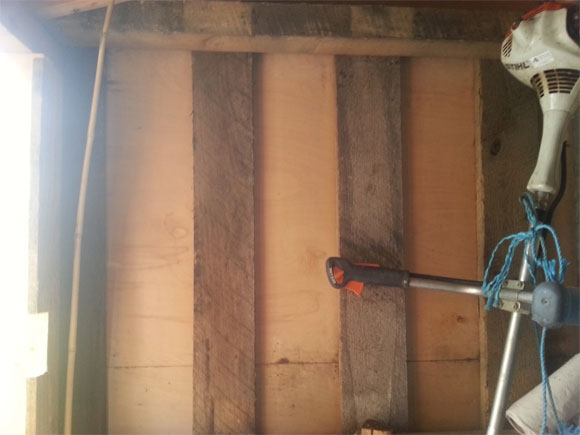
Pallets used to create the shed frame
These were then covered in slats on the outside and a living roof added on. It wouldn’t be us without the quirky handle, alternative down pipe and loveheart hole in the door!
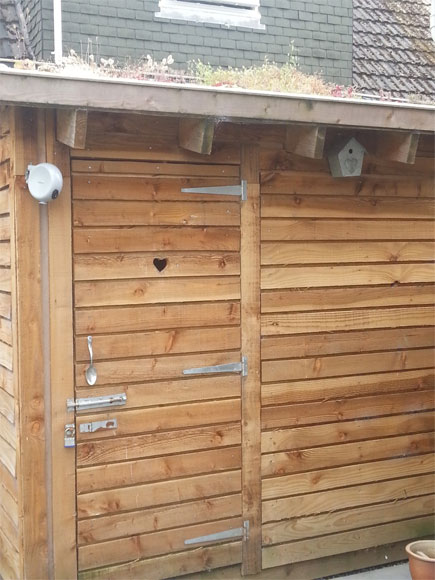
The completed shed
Next we are thinking about trying out a children’s bench. If you have ideas of other items that could be made from upcycled pallets we would love to hear them. Or if you want more information on ordering any of these items please get in touch.
Thanks for reading,
All at Vialii
Do You Do Room Service?
Everyone likes a nice, comfy home and bugs are no different from the rest of us. Many are happy to set up home under a pile of leaves or logs. But why not go a step further and create your own bug version of Gleneagles in your very own back garden with a 5 Star Bug Hotel? Here’s how to make a bug hotel…
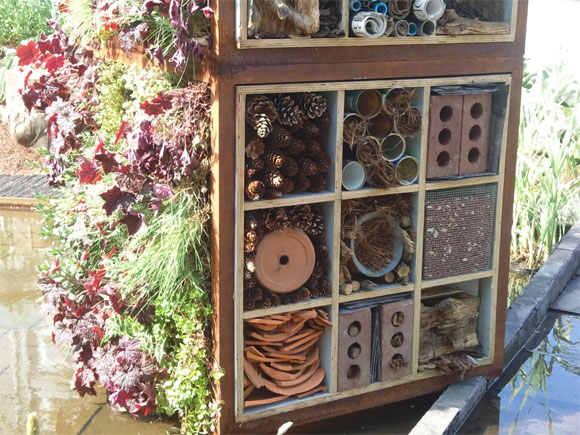
A stunning bug hotel from the Chelsea Flower Show
Many of us like to have a neat and tidy garden and by doing so we often eradicate the natural habitats bugs can call home. Or in a new garden with lots of hard landscaping and container planting there may be limited places for invertebrates to set up home. Bug hotels are purpose built structures which can be as simple or grand as you like.
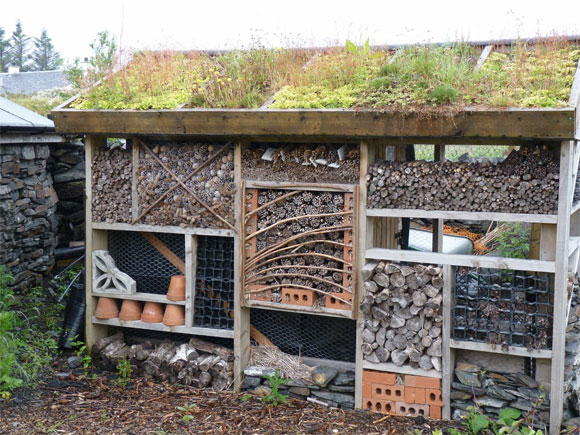
A bug hotel on Seil Island with a green roof
Designing A Bug Hotel
The first rule of creating a bug hotel is to incorporate a variety of materials and different shapes and sizes of nooks and crannies. Different bugs have different requirements so in order to be diverse and encourage as much wildlife as possible into your garden make sure you use a wide array of materials. Offer everything from single rooms up to penthouse suites with a spa thrown in for good measure!
[[image:blog/blog-roomservice-3.jpg=A stunning bug hotel from the Chelsea Flower Show using lots of different materials]]
If you can, do a rough design of what you want your bug hotel to look like. Most bug hotels are made from reclaimed material thus making them cheap and easy to build as well as good for the environment. You could use some old pallets which are easy to get hold of to create the different layers of your bug hotel. Or if you are feeling adventurous you could create a real focal point in your garden by building a tower similar to the fantastic work of art at the Chelsea Flower Show a few years ago.
Building A Bug Hotel
Building a bug hotel is a wonderful project to build with children and you can encourage them to collect the materials you are going to use. Many of these you will have lying around the house and you can ask friends and family to donate to your hotel. Ideal materials include:
- Bamboo canes
- Egg cartons
- Pieces of slate
- Straw
- Logs (drill the ends for even more places for bugs to set up home)
- Broken terracotta pots
- Old bricks
- Old roof tiles
Pack the various materials into different sections of your “hotel” and soon you will have created a home which looks interesting and will have wide appeal.
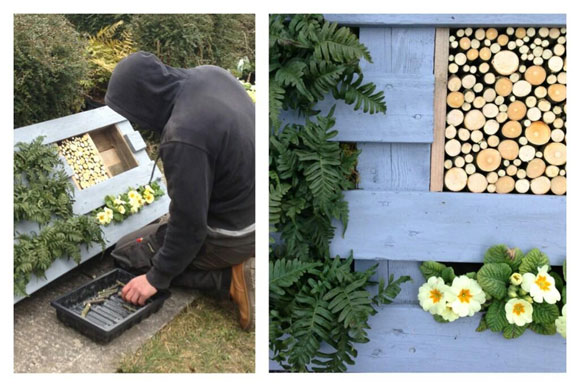
A pallet incorporating a bug hotel at RHS Cardiff Show
Bug Central
So what sort of bugs might pack their bags and move into their new home? Well , common sights include mason bees, woodlice, ladybirds, spiders, beetles and centipedes. By encouraging these bugs into your garden they will help you combat the pests which eat your plants and ruin your grass. Great guests to have and ones which always be welcome back! Wonder if you get Trip Advisor for beetles…
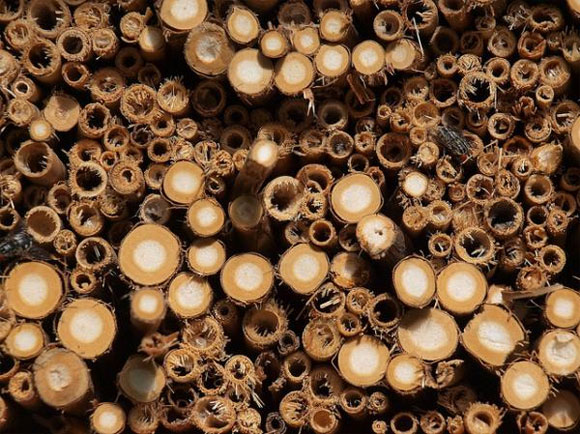
Lots of bamboo canes make an ideal home
If you want advice on building a bug hotel or other ways of turning your garden into a haven for wildlife please get in touch.
For more information on making your own bug hotel please visit our blogs Make Your Own Bug Hotel and How To Make A Bug Hotel.
All at Vialii
A Sustainable Future
It’s a common misconception that sustainability and being kind to the environment equates to being unkind on the wallet. Here are some ideas of how you can create a stunning sustainable garden whilst still doing your bit to help the planet and without breaking the bank…
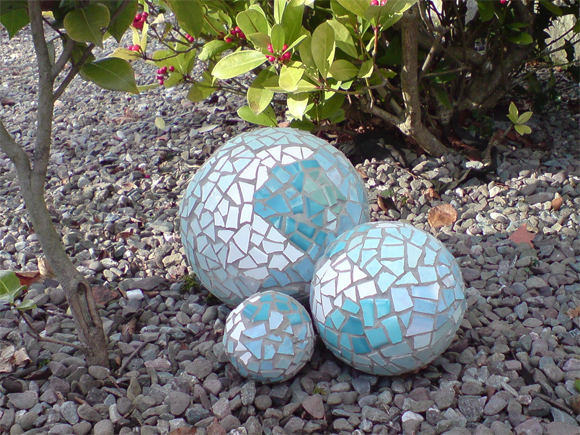
A mosaic ball is fun to create and reduces landfill
RECYCLE
Re-use all sorts of otherwise useless objects in the garden to create interesting features. Old bamboo canes, broken pots, egg cartons and old bricks can all be used to create a trendy wildlife tower. Or try using old slates stacked on their ends to create an interesting feature. Old concrete slabs are commonly lifted to be replaced by something more modern. However, they can be broken and re-laid to be a modern take on crazy paving. Or, if you are feeling like trying your hand at some crafts, how about making a mosaic ball out of left over tiles for a unique garden ornament.
FREECYCLE

Freecycle is a wonderful organisation
SHARE THE LOAD
Seed sharing is a great way to get free plants. Often a pack of seeds gives you far too many of the one plant. Swap some seeds with like-minded gardeners to widen your plant choice. Alternatively, you might have sown all your seeds but have too many plants for your own garden and have excess you are happy to give to a good home. Or perhaps you have excess fruit and veg you can’t get through yourself? There are some great websites that you can swap through or perhaps, if there is demand, we can create something locally. Let us know if you are interested.
SALVAGE YOUR GARDEN
There are salvage yards which are dedicated to supplying “scrap” for garden use. From sculptures and fountains to furniture and planters there are plenty of items which will make your garden completely unique and you will be saving it from landfill. If are looking for something a bit more unusual, look at non-garden salvage items and consider how it could be adapted to some use in your own garden such as an old wheel as part of a handrail.
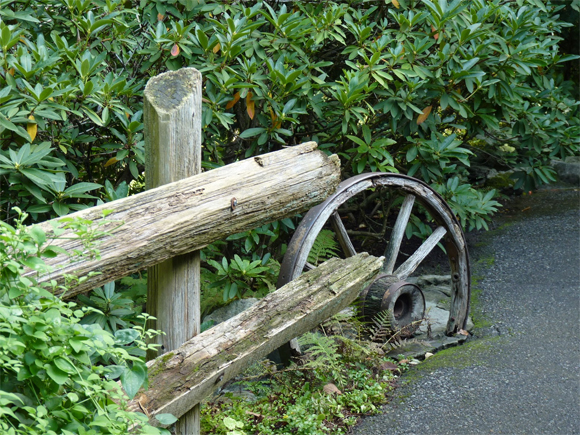
This upcycled wheel makes a great handrail in a garden in Canada
SOURCE FREEBIES
If you are about to embark on a garden project, before you head to your local DIY superstore consider alternative ways you can source the required materials. Local builders and landscapers often have left over materials they don’t need or scrap they have removed from a job which is destined for the local tip. Contact them to see if they have materials which suit your needs – what might have been someone’s deck in a previous life might become the frame for your new green roof.
CIRCLE OF LIFE
Re-use items from your own garden to create interesting new features. For instance, an old felled apple tree could be cut up into sections to create a contemporary wildlife log feature in a quiet, unused corner of the garden. By tempting wildlife into your garden, they will help you deal with the various pests in your garden in a non-biological way.
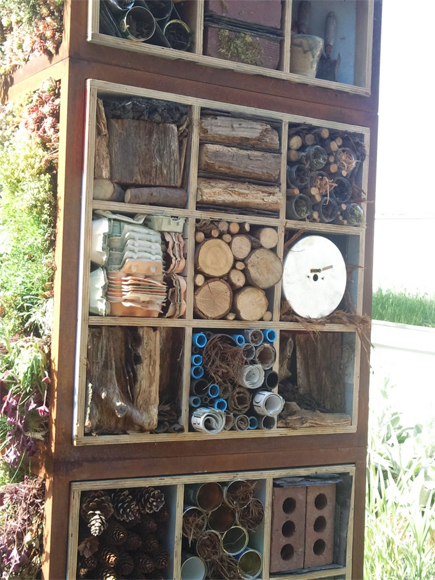
A trendy wildlife tower is a great way to recycle materials
HARD CHOICES
Consider your choice of hard landscaping carefully before you commit. Not only can paving be very expensive, many varieties are non-permeable, thus impacting on water levels in the area. And we all know how prevalent flooding has been recently! Consider alternatives such as gravel which is cheaper and allows excess water to permeate more easily.
SEED OF THOUGHT
If you have the time and patience, grow plants from seeds. Not only does it save money (especially if you have got them free as discussed earlier) but you avoid additional costs to the planet by avoiding the plastic pots which plants are sold in in garden centres. You are also avoiding transport costs of the plants from nursery to wholesaler, wholesaler to retailer then retailer to consumer. And of course there is the immense satisfaction of growing your own plants from tiny seeds. Priceless.
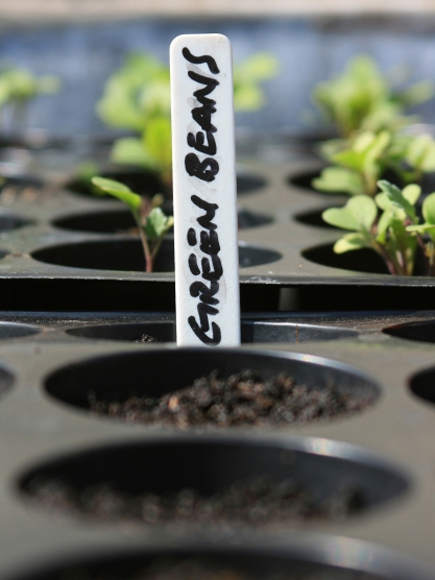
Growing plants from seed is immensely satisying
GO ORGANIC
The word “organic” can strike fear into the hearts of many a shopper as it can often seem an excuse to charge the customer more. However, when it comes to gardening, it can be a cheaper approach to horticulture, whilst doing your bit for the environment. For a start you won’t be buying any of those expensive chemicals to kill pests or keep them off your prize plants. Clever approaches such as companion planting is cheaper, can look pretty and keeps your conscience guilt free. Attracting wildlife into your garden, using some of the tips above, helps deal with the pests too. And simple old hard graft is the cheapest, most effective and kindest way to deal with your weeds (and great for calorie burning too!).
So now you can sleep well at night knowing you’re doing your bit for both your bank balance and the planet.
All at Vialii
Bridge of Allan Times
We explain how in these economically challenging times, you can sustain an environmentally friendly future whilst still maintaining your bank balance.
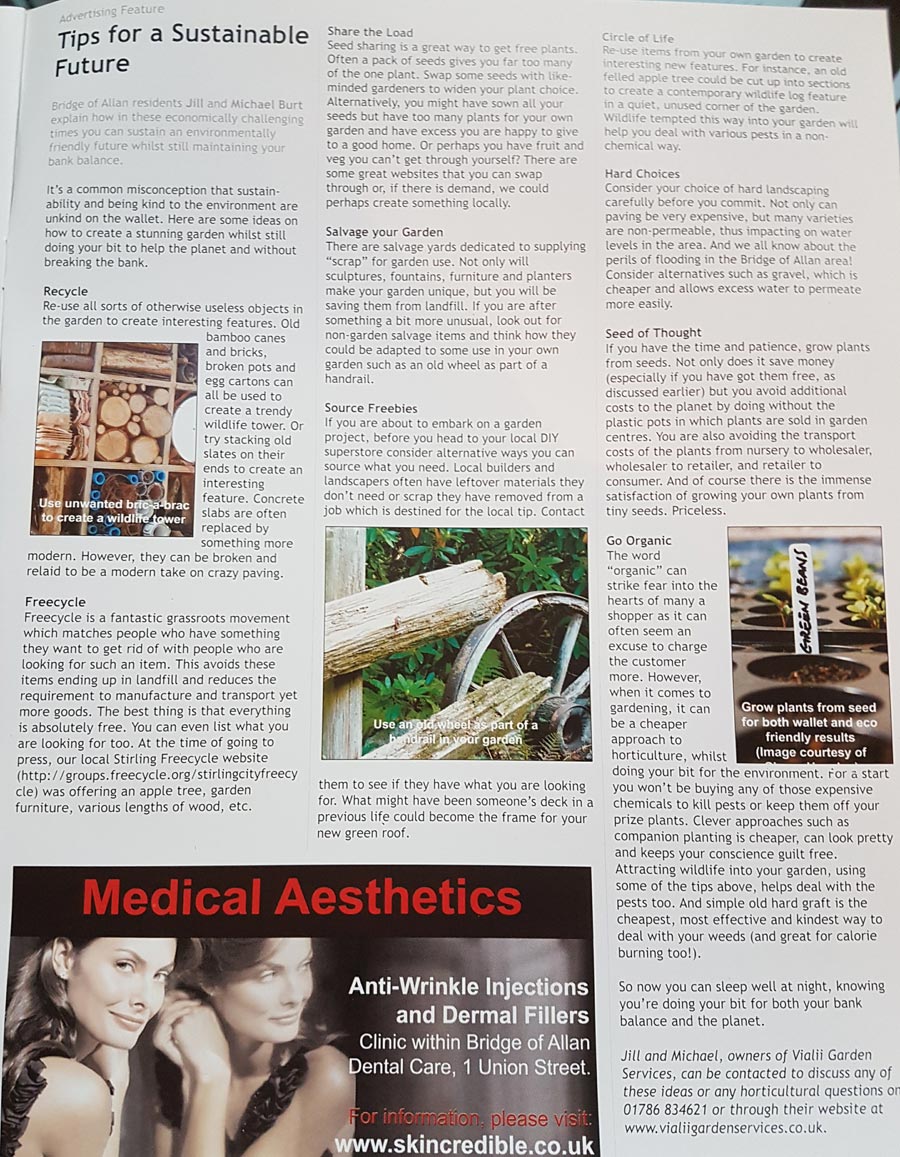
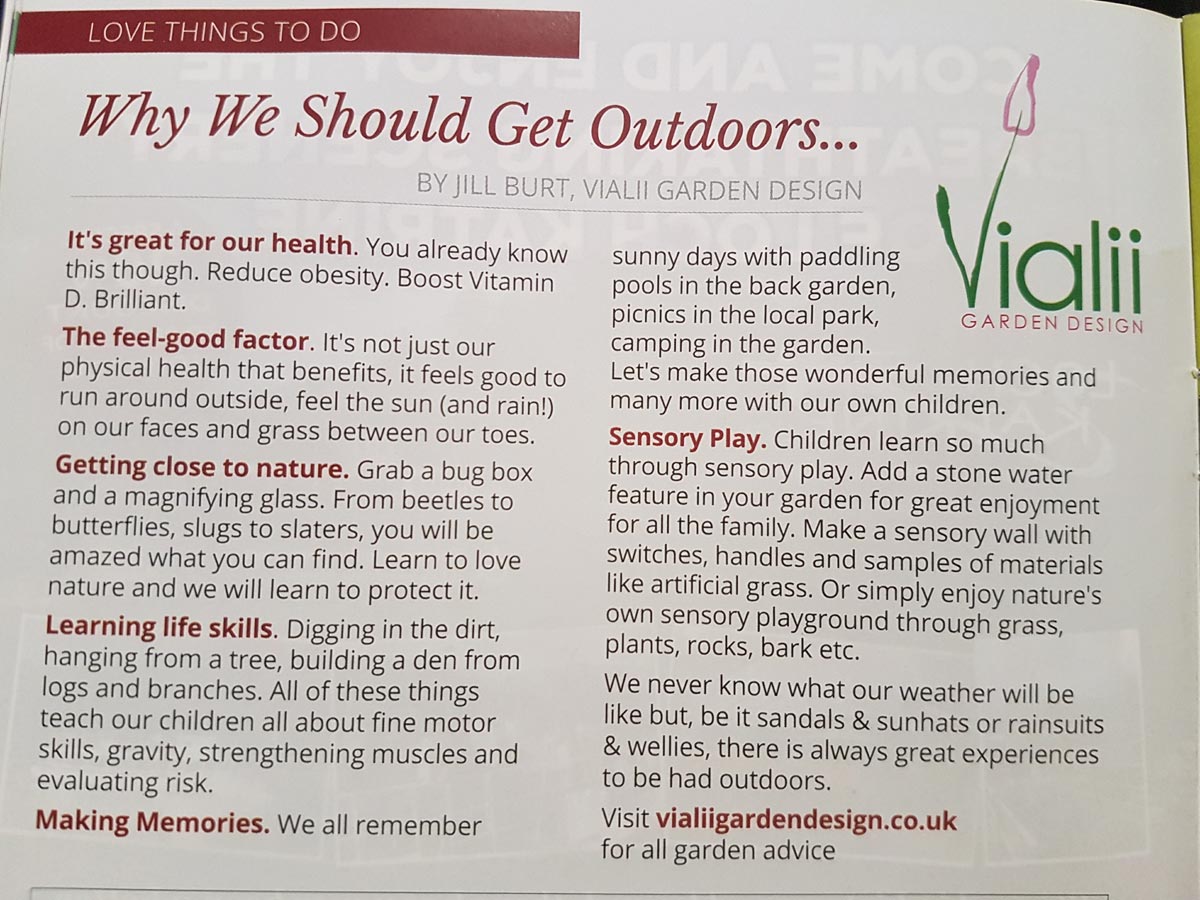
Wild About Your Garden
Bio-diversity. Sustainability. Eco-friendly. They are all buzz-words in the world of gardening as more and more people realise that it can be cool to care. The United Nations have even declared 2010 as the Year of Biodiversity. No longer does having a wildlife garden mean that you just leave an area of your garden to go “wild” and inevitably become an eye-sore.
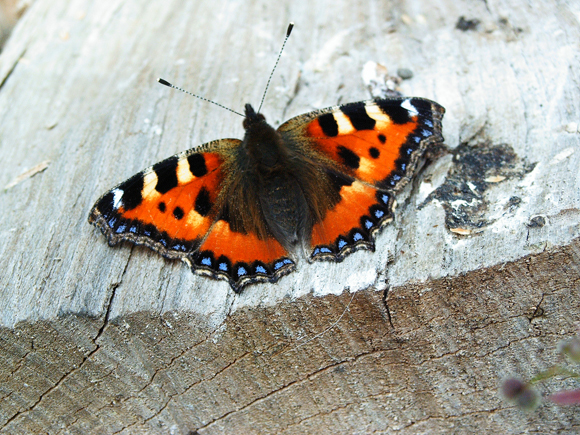
Having a wildlife garden can be truly beautiful
Even the Chelsea Flower Show this year featured heavily on wildlife gardens with one garden planted entirely with a wildlife meadow. Wildlife gardens can fit whatever style of garden you choose, from contemporary to traditional cottage garden. And even the smallest and most urban of spaces can attract the most surprising of visitors.
So, how can you create a wildlife garden and what, more interestingly, can you attract?
Perfect Planting
Planting should include native species and have some of the key features important to wildlife. Look at what grows naturally in the wild and what grows really well in your neighbours’ gardens. Native hedgerows such as beech, hazel or hawthorn will provide a haven for hundreds of species of wildlife.
Birds love winter berries so plants such as cotoneaster, viburnum, holly and skimmia are perfect.
Include plants that are efficient for bees to collect pollen from such allium, echinops and foxgloves as well as broad-leaved perennials which allow easy access for bees such as asters, sunflowers and echinacea. Avoid double flowers which make it difficult for bees to access pollen.

The bees loving the echinops in our garden
The world’s bee population is still in decline and it’s crucial we all take steps to reverse this trend. Einstein once said “If the bee disappeared off the surface of the globe then man would only have four years of life left. No more bees, no more pollination, no more plants, no more animals, no more man.”
Plants such as buddleja, lavender, scabious, forget-me-nots and lonicera (honeysuckle) are perfect for attracting butterflies into your garden.
Don’t deadhead plants as soon as the flowers go over. Instead leave seed heads which not only look beautiful throughout the winter but are also perfect for birds looking for seeds. Ideal for plants such as echinops, sedum and angelica.
Different species of trees and shrubs provide nectar and other food sources throughout the year so make sure you have a good mix of plants.
Grow climbers against walls to provide shelter for birds.
If you want to take it a stage further and if you have space, why not incorporate a wildflower meadow. The gold winning HESCO garden at the Chelsea Flower Show this year proved wildflower meadows can be beautiful as well as a haven for wildlife. Packets of wildflowers seeds or trays of plug plants are readily available from garden centres or online these days but make sure they originate from the UK.
Wildlife such as spiders, caterpillars, butterflies and moths, bees, birds and small mammals will all be tempted into your wildflower meadow. Nowadays wild flower meadows are extremely rare – we have lost 95% in the last 50 years. Planting one in your garden will really help local wildlife.
Water Wonderland
Incorporating some form of water feature into your garden is a great way of attracting wildlife. Water can be incorporated no matter what size or style your garden is and can be made child-friendly too.
If your garden is small then even a half barrel can be made into an effective water feature and will attract frogs and other wildlife which will feed happily on slugs and snails.
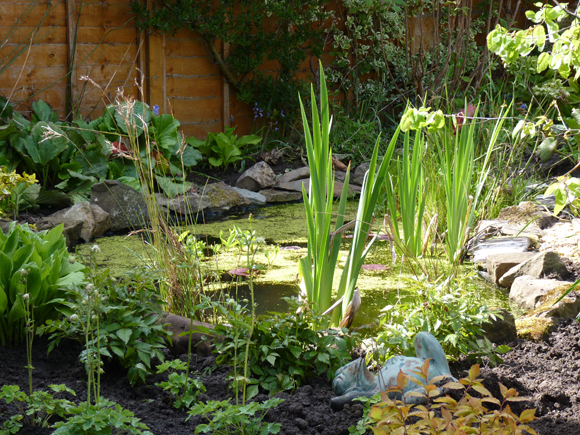
Water is a great way to attract wildlife into your garden
If your garden is a bit bigger, look at a larger pond. Incorporate “floating” stepping stones to make your pond very on-trend. Make sure there are sloping edges to your pond though so birds can bathe, frogs can spawn and hedgehogs can escape if they fall in. A mesh can be incorporated to make ponds child-friendly too.
Go Organic
Avoid using slug pellets and pesticides. Many are harmful to the “good” wildlife you are trying to attract. Instead look for alternatives. For weeds, hand-weeding, mulches, ground cover plants and weed suppressant fabrics will all help keep weeds at bay. And once you have started attracting wildlife in, they will do a lot of the work for you such as eating slugs.
Happy Habitats
Create the sort of habitats that are perfect for the wildlife you are trying to attract:
Put a nesting box in your garden. These can range from the traditional wooden boxes to boxes in trendy shapes and colours to suit all styles. Boxes will attract birds and possibly even bats. Many gardens have plenty to offer birds to eat but nowhere to nest.
Create a log pile somewhere quiet in your garden, perhaps hidden behind your shed. If you are lucky hedgehogs and toads may set up home there and help keep garden pests at bay.
Introduce a wildlife tower into your garden. It can be built out of old pieces of wood and the different sections incorporate different recycled materials such as bamboo canes, egg cartons and broken pots. The tower will provide a focal (and talking) point in your garden and be home to a myriad of wildlife.
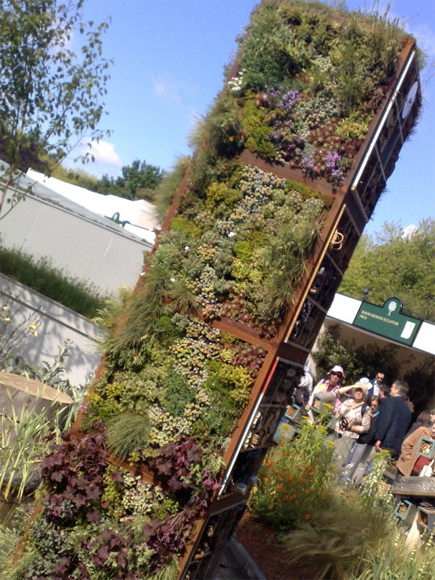
Water is a great way to attract wildlife into your garden
Include bird baths and bird tables in your garden to encourage our feathered friends to visit. Be careful where you site them though for curious cats…
Other easy additions are rock piles, a garden shed, a window box or even a simple hanging basket. All will entice wildlife into your garden.
Sustainable Gardening
Take simple steps to help our planet as well as saving yourself money:
- Introduce a compost heap for all your lawn clippings and dead-heading as well as your kitchen waste.
- Avoid using peat-based compost. Peat extraction destroys vital wildlife habitat.
- Include a water-butt somewhere in your garden. Not only do plants and wildlife prefer rain-water but it saves you getting the hose out.
So from lady-birds to lace-wings, hedgehogs to hoverflies, bees to butterflies or dragonflies to damselflies, gardens are a place both humans and wildlife can enjoy side by side.
We’d love to see pictures and hear stories of some of the wildlife you have tempted into your garden. Please get in touch with some of your tales.
All at Vialii